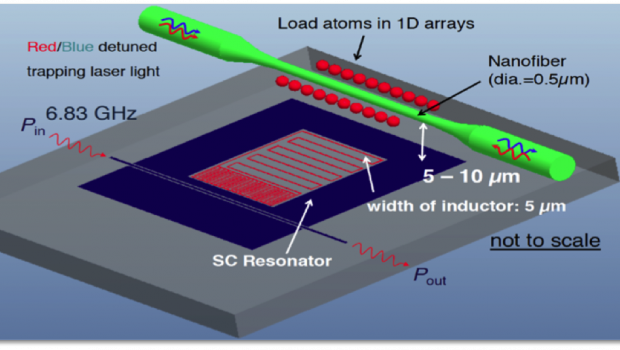
Remote Quantum Systems Produce Interfering Photons
Scientists at the Joint Quantum Institute (JQI) have observed, for the first time, interference between particles of light created using a trapped ion and a collection of neutral atoms. Their results could be an essential step toward the realization of a distributed network of quantum computers capable of processing information in novel ways.
High-resolution imaging technique maps out an atomic wave function
JQI researchers have demonstrated a new way to obtain the essential details that describe an isolated quantum system, such as a gas of atoms, through direct observation. The new method gives information about the likelihood of finding atoms at specific locations in the system with unprecedented spatial resolution. With this technique, scientists can obtain details on a scale of tens of nanometers—smaller than the width of a virus. The new experiments use an optical lattice—a web of laser light that suspends thousands of individual atoms—to determine the probability that an atom might be at any given location. Because each individual atom in the lattice behaves like all the others, a measurement on the entire group of atoms reveals the likelihood of an individual atom to be in a particular point in space. Published in the journal Physical Review X, the technique (similar work was published simultaneously by a group at the University of Chicago) can yield the likelihood of the atoms’ locations at well below the wavelength of the light used to illuminate the atoms—50 times better than the limit of what optical microscopy can normally resolve.
Glass fibers and light offer new control over atomic fluorescence
Electrons inside an atom whip around the nucleus like satellites around the Earth, occupying orbits determined by quantum physics. Light can boost an electron to a different, more energetic orbit, but that high doesn’t last forever. At some point the excited electron will relax back to its original orbit, causing the atom to spontaneously emit light that scientists call fluorescence. Scientists can play tricks with an atom’s surroundings to tweak the relaxation time for high-flying electrons, which then dictates the rate of fluorescence. In a new study, researchers at the Joint Quantum Institute observed that a tiny thread of glass, called an optical nanofiber, had a significant impact on how fast a rubidium atom releases light. The research, which appeared as an Editor’s Suggestion in Physical Review A, showed that the fluorescence depended on the shape of light used to excite the atoms when they were near the nanofiber.
Two-toned light pattern creates steep quantum walls for atoms
Exotic physics can happen when quantum particles come together and talk to each other. Understanding such processes is challenging for scientists, because the particle interactions can be hard to glimpse and even harder to control. Moreover, modern computer simulations struggle to make sense of all the intricate dynamics going on in a large group of particles. Luckily, atoms cooled to near zero temperatures can provide insight into this problem.Lasers can make cold atoms mimic the physics seen in other systems—an approach that is familiar terrain for atomic physicists. They regularly use intersecting laser beams to capture atoms in a landscape of rolling hills and valleys called an optical lattice. Atoms, when cooled, don’t have enough energy to walk up the hills, and they get stuck in the valleys. In this environment, the atoms behave similarly to the electrons in the crystal structure of many solids, so this approach provides a straightforward way to learn about interactions inside real materials. But the conventional way to make optical lattices has some limitations. The wavelength of the laser light determines the location of the hills and valleys, and so the distance between neighboring valleys—and with that the spacing between atoms—can only be shrunk to half of the light’s wavelength. Bringing atoms closer than this limit could activate much stronger interactions between them and reveal effects that otherwise remain in the dark. Now, a team of scientists from the Joint Quantum Institute (JQI), in collaboration with researchers from the Institute for Quantum Optics and Quantum Information in Innsbruck, Austria, has circumvented the wavelength limit by leveraging the atoms’ inherent quantum features, which should allow atomic lattice neighbors to get closer than ever before. The new technique manages to squeeze the gentle lattice hills into steep walls separated by only one-fiftieth of the laser’s wavelength—25 times narrower than possible with conventional methods. The work, which is based on two prior theoretical proposals, was recently published in Physical Review Letters.
JQI Podcast Episode 6 - Blackbody radiation: An "act of desperation" spurs a physics revolution
Solving the mystery of blackbody radiation brings on the quantum revolution. Phil Schewe, Emily Edwards, and Steve Rolston discuss this pivotal moment for modern physics. 2006 Nobel Prize laureate John Mather discusses how his work relates to blackbody radiation.